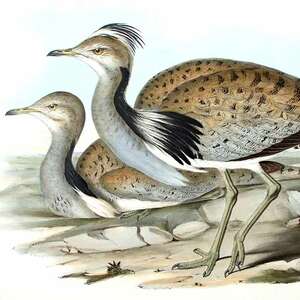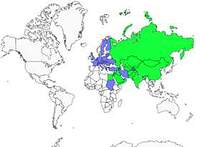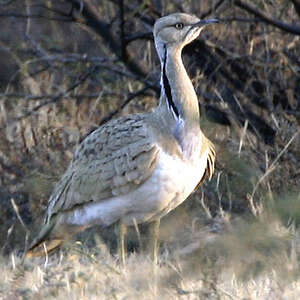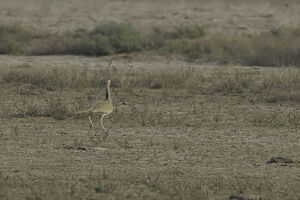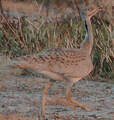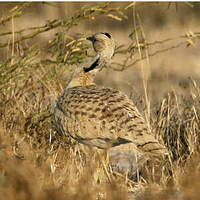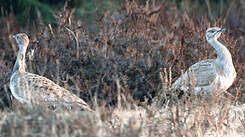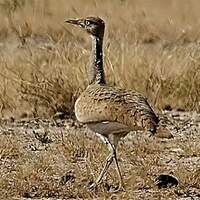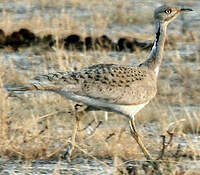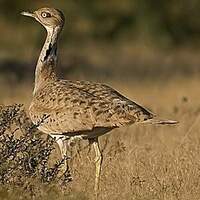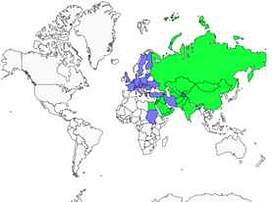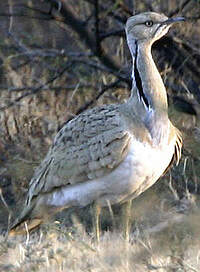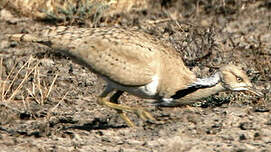Asian Houbara
Chlamydotis macqueenii - Outarde de Macqueen
Identification
Macqueen's Bustard is very closely related to Houbara Bustard, and only recently it has been recognized as a distinct species. Recent studies on their behavior, their songs, and genetics, have demonstrated considerable differences between Macqueen's Bustard and the Houbara Bustard. Chlamydotis macqueenii, is a medium-sized bustard, relatively pale, and with a slender body. Unlike most bustards, there is sexual dimorphism in this species. The adult male is distinctly larger than female, with longer and more visible erectile feathers at the back of the crown, neck, and chest. It has more black on the sides of the chest. The adult's upper plumage is a rather pale chamois-grey with spots and dark brown points that become less noticeable on the wing coverts. The tail has three visible large blue-grey bands. The chamois crown is sometimes masked by a white band of erectile feathers, the rest of the face being pale chamois-grey. A long blackish band composed of filamentous and erectile feathers descends from each side of the whitish neck to the chest. The underside is light and the legs are green-olive or yellow-straw.
Subspecific information monotypic species
Foreign names
- Outarde de Macqueen,
- Avutarda hubara asiática,
- abetarda-de-macqueen,
- Steppenkragentrappe,
- pettyes túzok,
- Oostelijke Kraagtrap,
- Ubara asiatica,
- kragtrapp,
- Steppetrappe,
- drop hrivnatý,
- drop obojkový,
- Østlig Kravetrappe,
- idänkaulustrappi,
- hubara asiàtica,
- Macqueendoðra,
- hubara arabska,
- apkakles sīga,
- ovratničarska droplja,
- Джек,
- サバクフサエリショウノガン,
- 波斑鸨,
- 麥昆氏波斑鴇,
Habitat
Macqueen's Bustard is a remarkable bird found in deserts and semi-arid grasslands across Asia, including the Middle East up to Mongolia.
DISTRIBUTION: The Middle East from Arabia to Iran and Eastern Pakistan, also present in the Northwest of Kazakhstan to Mongolia and China. Winters from the Persian Gulf to India.
Behaviour character trait
Macqueen's Bustard is more roving than its cousin, the Houbara.
As with other bustards, their courtship display is very spectacular. They erect their long white throat plumes while tossing their head back. Circling and zigzagging are some of the movements of their white crest. It can be seen alone or in pairs, but large gatherings of them can be observed in the winter.
Flight
Dietfeeding habits
Reproduction nesting
The breeding season is not very fluctuating despite differences in longitude. It is from March to April in Pakistan. The nest is a simple bowl that the bird has dug into the ground. It chooses its location near a bush for protection from predators. Two to four eggs are laid. Incubation lasts about 24 days. The chicks are covered in a fawn-colored down mottled with black, white, and sepia spots, giving them perfect camouflage in their usual environment.
Threats - protection
IUCN conservation status
concern
in the Wild
threatened
evaluated
In the West of its distribution range, Arab falconers, who considered the Macqueen's Bustard as the supreme game bird, almost exterminated it. If the excesses of its hunting are one of the causes of its decline, it is the degradation of its habitat, which is the main responsible. The government of Saudi Arabia has made great efforts to ensure the management and conservation of the species. IUCN Conservation Status: VU (Vulnerable).
Sources of information
- IOC World Bird List (v14.2), Gill, F and D Donsker (Eds). 2024-04-18.
Other sources of interest
 Specification sheet created on
03/08/2023 by Jean-Pierre Trouillas
Specification sheet created on
03/08/2023 by Jean-Pierre TrouillasTranslation by AI Oiseaux.net
© 1996-2025 Oiseaux.net
- Accipitriformes
- Aegotheliformes
- Anseriformes
- Apodiformes
- Apterygiformes
- Bucerotiformes
- Caprimulgiformes
- Cariamiformes
- Casuariiformes
- Charadriiformes
- Ciconiiformes
- Coliiformes
- Columbiformes
- Coraciiformes
- Cuculiformes
- Eurypygiformes
- Falconiformes
- Galliformes
- Gaviiformes
- Gruiformes
- Leptosomiformes
- Mesitornithiformes
- Musophagiformes
- Nyctibiiformes
- Opisthocomiformes
- Otidiformes
- Passeriformes
- Pelecaniformes
- Phaethontiformes
- Phoenicopteriformes
- Piciformes
- Podargiformes
- Podicipediformes
- Procellariiformes
- Psittaciformes
- Pterocliformes
- Rheiformes
- Sphenisciformes
- Steatornithiformes
- Strigiformes
- Struthioniformes
- Suliformes
- Tinamiformes
- Trogoniformes

